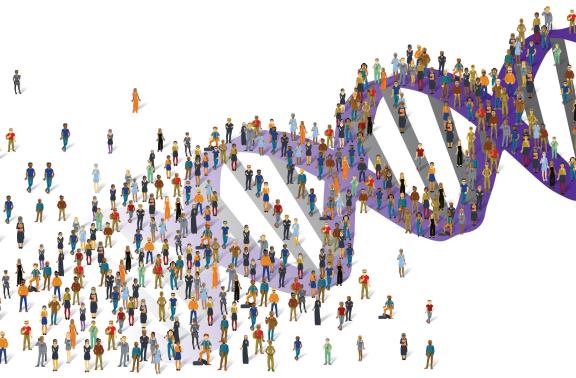
A Bigger View: Ingrid Holm on Sharing Research Tools
CERA staff spoke with Ingrid A. Holm, MD, MPH, Professor of Pediatrics, Harvard Medical School, in April about two research instruments she deposited into the Research Tools Database on ELSIhub. Dr. Holm is a medical geneticist by training and has been an ELSI researcher since 2009. Her first ELSI study was a National Institutes of Health (NIH) Challenge Grant on the ethical return of research results to parents of children enrolled in a longitudinal genotype-phenotype registry. Since this study, 12 years ago, Dr. Holm has identified herself as an ELSI researcher.
Dr. Holm shared two surveys administered at multiple research sites in the Electronic Medical Records and Genomics (eMERGE) III study. This study, the third phase of a National Human Genome Research Institute (NHGRI)-funded consortium, returned clinically relevant, actionable genetic results to participants and tracked clinical outcomes through electronic health records. The surveys, Common survey items, eMERGE participant survey at 0-1 month post disclosure of genetic test results and Common survey items, eMERGE participant survey at 6-12 months post disclosure, elicit demographic information and offer repeated measures of participants’ feelings about study enrollment and test results, reasons for disclosing or not disclosing test results to family members, discussions with and recommendations from healthcare providers, and plans for follow up care and behavior change. We asked Dr. Holm why she developed these surveys and her expectations about the benefit of a publicly available research tools database for ELSI researchers.
CERA: Could you please explain why you developed these tools?
Dr. Holm: I was the Co-Chair of the Return of Results (ROR)/ELSI Workgroup of eMERGE III. In eMERGE, all sites were conducting a participant survey and although the surveys were all different, there were many common themes. My raison d'être became to coordinate at least some of the survey questions across sites so that we could pool the results, giving us more power to analyze the data, since the number of participants who received a positive genetic test result in eMERGE was not that great. Across all of eMERGE, if 1000 participants had a positive result returned, that is on average 100 at each of the ten sites, and if less than half of them respond to the surveys, then you have data from less than 50 people per site. By asking the same survey questions across sites, you instead have about 300-500 eMERGE study participants that have answered the same survey questions. This leads to greater statistical power to answer questions and make comparisons.
CERA: Why did you decide to donate these research tools to the ELSIhub Research Tools Database?
Dr. Holm: I thought that giving these surveys to CERA was important because then other people can use these same measures. Unfortunately, in eMERGE, even though we decided on the same measures across sites, many of the sites still asked the questions in different ways, and had answers, that were a little different. It took over a year to reconcile the differences. My hope is that others won’t make that same mistake and instead decide on a measure and use it as is. If you change the measure, you can’t directly compare across studies. I shared these tools because I felt pretty passionately that a Research Tools Database for ELSI researchers will facilitate research that is not siloed but allows more direct comparisons of findings between studies. It also makes sense, and is more efficient, to utilize measures that have already been developed and used successfully.
CERA: How do you think the Research Tools Database can benefit scholars and/or scholarship on the ethical, legal, and social implications of genetics and genomics?
Dr. Holm: ELSI research tends to be smaller studies that look at specific areas. I also do genetics research to identify gene variants that contribute to Sudden Infant Death Syndrome (SIDS). Variant data is easily shared as it is collected in the same way. I think it would benefit ELSI to have some well-developed tools that are broadly used so data could be more easily shared. Then you can start to look at, not just my little area, but how findings in that area compare to other areas. Maybe we can find better ways to do things, or answer ELSI questions in better ways, if we have a bigger view, as opposed to a narrower view.
I also think ELSI research could benefit from taking a broader view and bringing people together. During eMERGE, because all sites were willing to share what they were doing with participant surveys and get together and decide on some agreed upon questions, we were eventually able to get more out of the data. The other organization that has done that is the Clinical Sequencing Evidence-Generating Research (CSER) Consortium. I met with Stacy Gray, who was at the Dana-Farber Cancer Institute, when I started in eMERGE III, to discuss how she did something similar with the cross-site CSER surveys.
Data sharing is important to the NIH and to science. In genetics there is no choice--you have to share your genetic data if you are funded by the NIH, and often it is required by journals. I actually think it would be nice if there was a policy about sharing methods, or other types of data, in ELSI research. In many other aspects of science, resource sharing is a requirement – why not in empirical ELSI research too?
CERA surveyed ELSI Congress registrants and members of the American Society of Bioethics and Humanities, ELSI Affinity Group in 2020 to elicit information about how the ELSI scholarly community felt about sharing research instruments that they have developed. A majority (70%) of the 336 survey respondents said they would be willing to deposit research tools into a publicly available repository, even if there was no requirement that they do so. The most popular benefits of doing this were the ability to compare results across studies (endorsed by 60% of respondents), the ability to see what exists before developing new instruments (52%), citation by those who use my research instruments (43%), and the possibility of having one’s own results replicated (42%). We also asked which tool characteristics were most relevant to the decision to use a tool from a public repository. Here, most respondents endorsed permission to modify the instrument (47%), peer-reviewed validation (43%), transparent methods of construction (43%), culturally appropriate for my population (40%), and ability to consult with the creator of the instrument (40%).
Despite support for the above benefits, survey respondents also expressed concerns about depositing research tools into a public repository. The most popular concern was use by others without proper credit (39%). Respondents also indicated a preference for potential tool users to ask their permission (31%) as well as concerns about competition in their research area (18%), unsolicited critique (13%), and that their instruments would not have broader utility (9%). To summarize these findings, the ELSI community would contribute research instruments to a publicly available research tool repository, but with some reservations. On a positive note, like Dr. Holm, the majority of community members agreed that the ability to make comparisons between ELSI studies on the same topic would be a worthwhile benefit to the field.
Concerns about sharing research instruments you have developed (n = 336)
|
Concern about use without proper credit/ attribution |
39% |
|
I would prefer potential users ask my permission |
31% |
|
Concern about competition in my research area |
18% |
|
Concern about unsolicited critique |
13% |
|
The instruments I create would not have broader utility |
9% |
|
I consider research instruments to be proprietary products of our research |
5% |
|
My organization/ institution does not allow research instrument sharing |
3% |
|
Loss of licensing income from my proprietary instruments |
1% |
|
None of the above |
14% |
|
Not applicable, I have never created instruments for empirical research |
18% |
The Research Tools Database on ELSIhub provides an exciting opportunity to share the research instruments you have developed, including surveys, interview guides, consent templates, and more, with the broader ELSI community. As the eMERGE case illustrates, collecting data using the same instrument across multiple sites can increase statistical power and offer researchers the ability to explore questions they might not have been able to otherwise. In some cases, qualitative researchers could also benefit from data collected across age groups, clinical phenotypes, or geographies. Overcoming the concerns of individual researchers in order to achieve the “bigger view” of ELSI issues advocated by Dr. Holm will require the community to embrace collaborative ways of working. We hope that ELSI scholars will express their support for a move in this direction by making individual contributions to the Research Tools Database on ELSIhub.
If you would like to share published or unpublished research instruments that you have developed with the ELSI community, please email your instrument to us at [email protected] and provide some basic information about the contribution (purpose, author, date created, and any relevant citations, as applicable).


